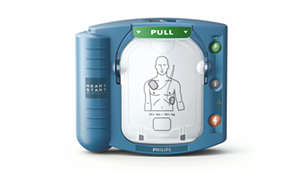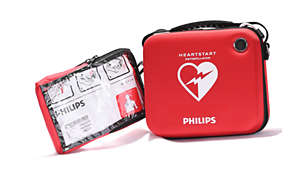What is an AED?
An automated external defibrillator (AED) is a portable defibrillator that checks a person’s heart rhythm and delivers a shock if the AED determines the patient has a shockable rhythm such as irregular heart rhythms, or ventricular fibrillation. If a person suddenly collapses and stops breathing, they may be suffering from sudden cardiac arrest (SCA) and SCA is serious. It means a person’s heart has stopped pumping blood and they need help fast in order to restore their heart to a normal rhythm or SCA can be fatal.

The most important element in the treatment and aid of SCA is not only CPR (cardiopulmonary resuscitation), but to provide a rapid electrical shock to their heart called defibrillation. An AED device helps ordinary people to provide defibrillation quickly to help save lives. HeartStart AEDs are the only AED (automated external defibrillators) approved by the FDA for sale over the counter without a prescription.
How do I use an AED?
Philips portable defibrillators come equipped with integrated SMART Pads. Just place the SMART Pads on the person’s bare skin and the pads will provide feedback to the AED so calm, step-by-step voice instructions can guide you through the entire process of using the AED until emergency services can arrive. Replacement AED supplies, such as electrode pads, batteries and accessories are available online if you use your AED in an emergency.
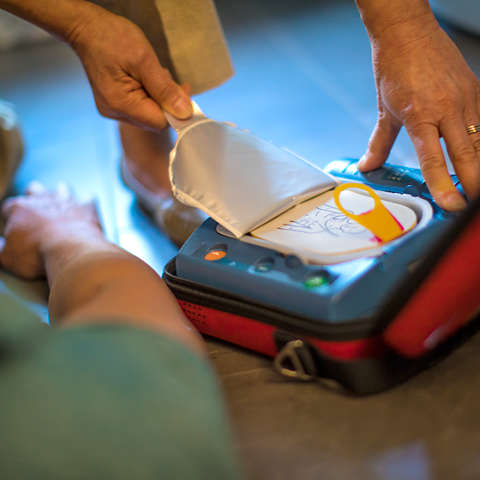
Pull the handle to activate the AED
HeartStart AEDs arrive with the Adult SMART pads cartridge and battery already installed and is positioned inside the carry case. After you set up the device, simply pull the handle to activate your defibrillator.
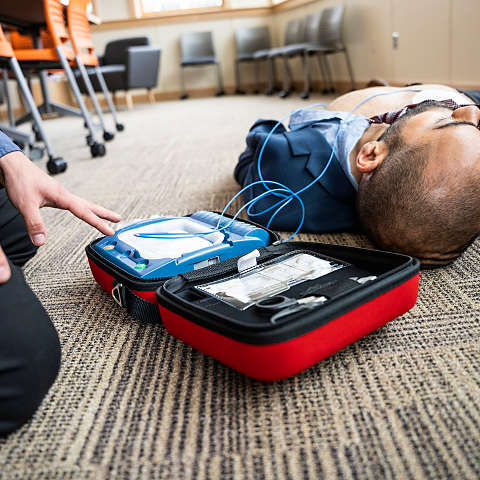
It guides you through every step
Once you pull the green handle to activate the AED, voice instructions will guide you through the entire process – from placing the electrode pads on the patient to performing CPR and delivering electrical therapy.

AED delivers fast shock therapy
This medical device features patented Quick Shock, which typically administers a shock just eight seconds after CPR, making the OnSite among the fastest in its class at delivery treatment after CPR. Studies show that minimizing time to shock after CPR may improve survival.1-4
Why are AEDs so important?
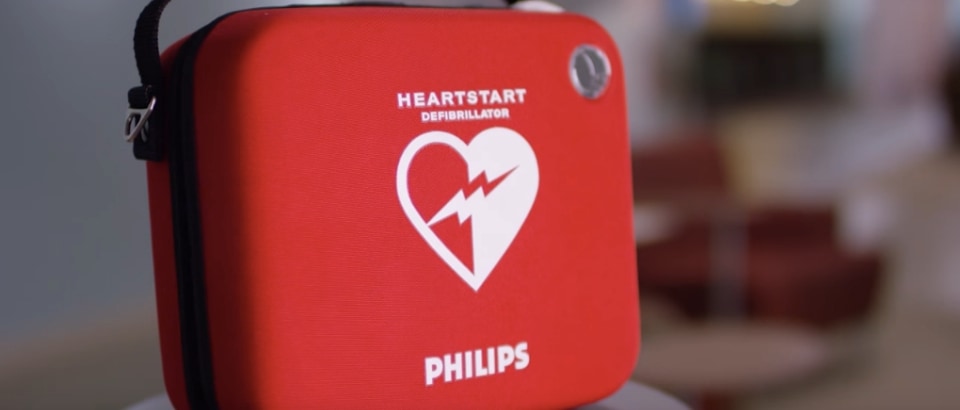
Our lineup
-
HeartStart HS1
The Philips HeartStart HS1 is designed for the ordinary person in the extraordinary moment. Philips HeartStart HS1 defibrillator acts as your personal coach to guide you through the process of treating a victim of suspected sudden cardiac arrest. TheHeartStart HS1 AED provides real-time guidance through simple, step-by-step voice commands and CPR coaching.¹
M5066A -
HeartStart FRx
The Philips HeartStart FRx defibrillator features intuitive, step-by-step voice instructions, including CPR guidance, and an audible metronome to help guide basic life support (BLS) responders while treating a suspected sudden cardiac arrest (SCA) Pre-connected SMART Pads II can be used for both adults and children. Rugged, lightweight and reliable, it can withstand rough handling and extreme temperatures. When every minute counts, Philips HeartStart FRx is the partner by your side. Side by side. Step by step.
861304
What to know before you buy an AED
AED FAQs
Owning an AED
Buying for an organization or business:
More about Philips AEDs
General information
Emergency Care solutions
Audiences
References 1. Eftestol, T., Sunde, K., & Steen, P. A. (2002). Effects of interrupting precordial compressions on the calculated probability of defibrillation success during out-of-hospital cardiac arrest. Circulation, 105(19), 2270-2273. Retrived from https://www.ncbi.nlm.nih.gov/pubmed/12010909 on August 20, 2018. 2. Yu, T., Weil, M. H., Tang, W., Sun, S., Klouche, K., Povoas, H., & Bisera, J. (2002). Adverse outcomes of interrupted precordial compression during automated defibrillation. Circulation, 106(3), 368-372. 3. Snyder, D., & Morgan, C. (2004). Wide variation in cardiopulmonary resuscitation interruption intervals among commercially available automated external defibrillators may affect survival despite high defibrillation efficacy. Critical care medicine, 32(9 Suppl), S421-S424. Retrieved from from https://journals.lww.com/ccmjournal/Abstract/2004/09001/Wide_variation_in_cardiopulmonary_resuscitation.16.aspx 4. Edelson, D. P., Abella, B. S., Kramer-Johansen, J., Wik, L., Myklebust, H., Barry, A. M., . . . Becker, L. B. (2006). Effects of compression depth and pre-shock pauses predict defibrillation failure during cardiac arrest. Resuscitation, 71(2), 137-145. doi: https://doi.org/10.1016/j.resuscitation.2006.04.008
